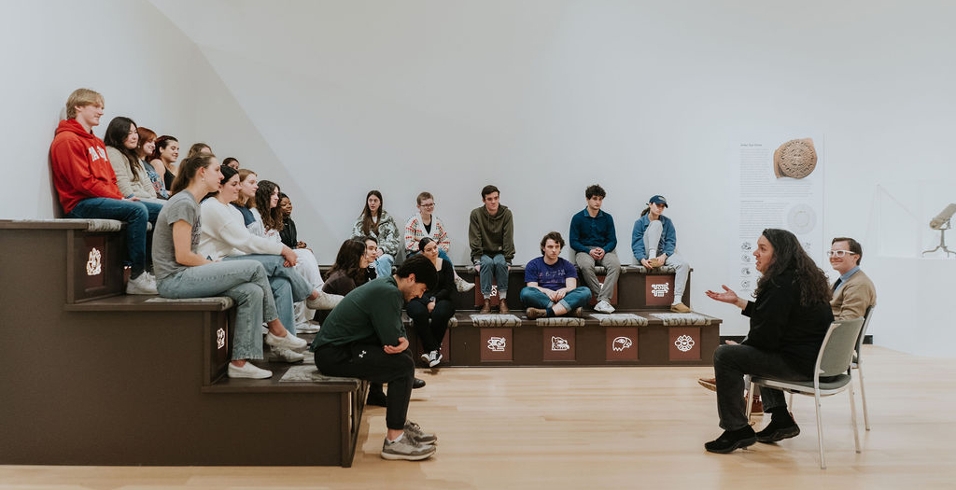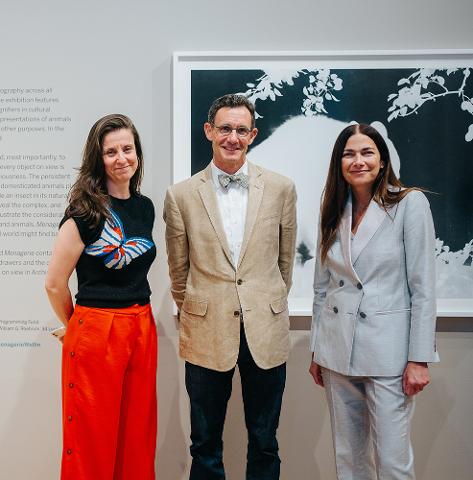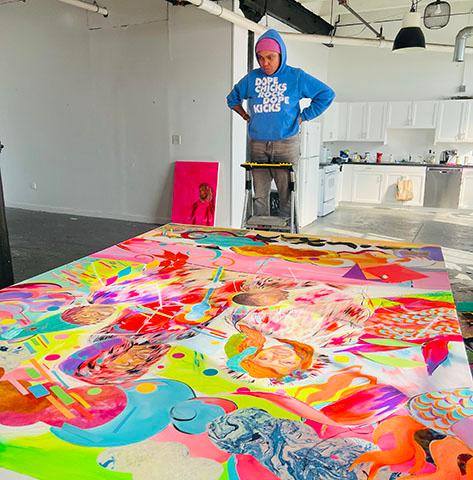Janelle Rodriguez

March 26, 2024
Along the south wall of the Wellin Museum’s main gallery, visitors to the exhibition René Treviño: Stab of Guilt will find an array of 119 acrylic paintings, each measuring 18 by 18 inches and displayed in a grid of seven rows and seventeen columns. To succinctly summarize the subject matter of this grid, titled the Circumference series, would be difficult—depictions of priceless artifacts sit next to images of thrift store souvenirs, recreations of scientific diagrams are positioned next to visages of sewer grates and disco balls, and enormous celestial bodies are rendered at the same scale and with as much attention as small foodstuffs. The overarching compositional connection among these works is the fact that they all feature a circular object set within the square dimensions of the canvas (or, more precisely, Dura-lar). Upon analyzing the images of this grid, however, viewers can begin to form various relationships connecting these otherwise disparate images, and all of these interpretations would be valid in the opinion of the artist, who describes this work as the “Google Image search of my own creative mind.”
When I look back at this series, it reminds me of one of the most important aspects of any contemporary art curator’s job—getting to know the artist you will be exhibiting as much as possible. With each passing month of collaboration, I aim to crawl further and further inside the beautiful labyrinth that is the mind of the artist I’m currently working with. And thanks to the exhibition strategy at the Wellin, I have many, many months to spend with our artists. As an example, I began collaborating with René Treviño in 2021, a full three years before Stab of Guilt opened to the public. There is no substitute for time, and I can easily assert that the final version of the exhibition we created with Treviño would not have been as dynamic, cohesive, or engaging without that amount of time to dream, deliberate, and create with him. And yet, for all the insights I have amassed about his work, I was recently reminded that I will only ever know as much about René and his practice as my own perspective and personal bias will allow for. In point of fact, I have known the artist since 2018, but I have always approached his practice through the lens of visual art and as a heterosexual, white male. When the artist recently visited campus for five consecutive days of studio visits, lectures, and class visits, he interacted with students and faculty from a wide range of backgrounds and who were studying various disciplines, including physics, gender studies, Latin American studies, religious studies, and theatre, among many others. Just by listening attentively in the same room where these conversations were taking place, I learned an incredible amount regarding the artist’s beliefs and his own past that I otherwise would have probably never known.
Several students who had grown up in Texas (where Treviño was born and raised), for instance, asked the artist questions about that state that I frankly do not have any context for whatsoever, and it was quite enjoyable to learn about Tex-Mex cuisine, rodeos, and the best ways to cool yourself off on a scorching summer day in the South. Other students, who identify as Latino/a, asked Treviño questions about the Latin American experience in our country that I may have never considered, and still other students who identify as members of the LGBTQ community earnestly sought advice about navigating a world in which they do not always see themselves reflected or valued. Through this line of questioning, I learned the importance of teaching in a college setting for René. I knew that teaching young art students can actually be a generative process for artists, and I am keenly aware of the value of a steady paycheck for practicing artists, but I had never before realized that Treviño feels called to be a professor in no small part because he wants to be an example and a resource for students who are queer and/or Latino/a. He wants these students to see themselves reflected in the faculty ranks, and to possibly have a better educational experience than he did.
Perhaps most enlightening of all were Rene’s conversations with members of the theatre department. I already knew that René’s first undergraduate degree was theatre, that he had made a living in New York City working in costume shops on Broadway, and that the Regalia series he produced for the Wellin exhibition marked a return to costume design for him. But over the course of several conversations with students and faculty, I slowly began to realize how much of Treviño’s painting and collage practice stems from the discipline of theatre. His preferred palette and choice of color, his attraction to industrial design, the importance of gallery architecture in complementing his work, and the way he conceives of some of his pieces as maquettes for larger textile or performance-based works all stem from a sensibility he first established as a theatre student. And this all made even more sense when I learned how valuable the theatre community had been for him in his formative years. Speaking to one class about the experience of living in a conservative state as a queer Latino who was not public about his sexual preference, the artist characterized the community that he found within his undergraduate campus theatre department as having at least saved his sanity, if not also his life.
I am thankful to have had so many years to get to know the multi-faceted artist René Treviño and also grateful to work on a campus where I have the opportunity to interact with so many students and faculty from a multitude of backgrounds and life experiences. It is gratifying that the Wellin Museum provides the entire Hamilton College community with access to our exhibiting artists, not just the art and art history departments. During René Treviño’s week of campus programming this spring, it was the students who ultimately taught me many new things—about the artist, about his work, and about the ways in which our exhibitions can positively affect their education and worldview at Hamilton and beyond.







